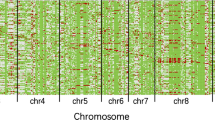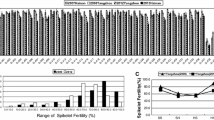Abstract
One outcome of hybrid breakdown is poor growth, which we observed as a reduction in the number of panicles per plant and in culm length in an F2 population derived from a cross between the genetically divergent rice (Oryza sativa L.) cultivars ‘Sasanishiki’ (japonica) and ‘Habataki’ (indica). Quantitative trait locus (QTL) analysis of the two traits and two-way ANOVA of the detected QTLs suggested that the poor growth was due mainly to an epistatic interaction between genes at QTLs located on chromosomes 2 and 11. The poor growth was likely to result when a plant was homozygous for the ‘Habataki’ allele at the QTL on chromosome 2 and homozygous for the ‘Sasanishiki’ allele at the QTL on chromosome 11. The results suggest that the poor growth found in the F2 population was due to hybrid breakdown of a set of complementary genes. To test this hypothesis and determine the precise chromosomal location of the genes causing the hybrid breakdown, we performed genetic analyses using a chromosome segment substitution line, in which a part of chromosome 2 from ‘Habataki’ was substituted into the genetic background of ‘Sasanishiki’. The segregation patterns of poor growth in plants suggested that both of the genes underlying the hybrid breakdown were recessive. The gene on chromosome 2, designated hybrid breakdown 2 (hbd2), was mapped between simple sequence repeat markers RM3515 and RM3730. The gene on chromosome 11, hbd3, was mapped between RM5824 and RM1341.




Similar content being viewed by others
References
Amemiya A, Akemine H (1963) Studies on embryo culture in rice plant. 3. Biochemical genetic studies on the root growth inhibiting complementary lethals in rice plant. Bull Nat Inst Agr Sci D10:139–226
Ashikari M, Sakakibara H, Lin SY, Yamamoto T, Takashi T, Nishimura A, Angeles ER, Qian Q, Kitano H, Matsuoka M (2005) Cytokinin oxidase regulates rice grain production. Science 309:741–745
Basten CJ, Weir BS, Zeng ZB (2005) QTL cartographer, ver. 1.17. Department of Statistics, North Carolina State University, Raleigh
Brondani C, Rangel PHN, Brondani RPV, Ferreira ME (2002) QTL mapping and introgression of yield-related traits from Oryza glumaepatula to cultivated rice (Oryza sativa) using microsatellite markers. Theor Appl Genet 104:1192–1203
Churchill GA, Doerge RW (1994) Empirical threshold values for quantitative trait mapping. Genetics 138:963–971
Coyne JA, Orr HA (2004) Speciation. Sinauer, Sunderland, pp 247–281
Dobzhansky T (1936) Studies on hybrid sterility. II. Localization of sterility factors in Drosophila pseudoobscura hybrids. Genetics 21:113–135
Dobzhansky T (1970) Genetics of the evolutionary process. Columbia University Press, New York, pp 311–350
Doerge RW, Churchill GA (1996) Permutation tests for multiple loci affecting a quantitative character. Genetics 142:285–294
Ebitani T, Takeuchi Y, Nonoue Y, Yamamoto T, Takeuchi K, Yano M (2005) Construction and evaluation of chromosome segment substitution lines carrying overlapping chromosome segments of indica cultivar ‘Kasalath’ in a genetic background of japonica elite cultivar ‘Koshihikari’. Breed Sci 55:65–73
Fukuoka S, Namai H, Okuno K (1998) RFLP mapping of the genes controlling hybrid breakdown in rice (Oryza sativa L.). Theor Appl Genet 97:446–449
Fukuoka S, Newingham MCV, Ishtiaq M, Nagamine T, Kawase M, Okuno K (2005) Identification and mapping of two new loci for hybrid breakdown in cultivated rice. Rice Genet Newsl 22:29–31
Hittalmani S, Shashidhar HE, Bagali PG, Huang N, Sidhu JS, Singh VP, Khush GS (2002) Molecular mapping of quantitative trait loci for plant growth, yield and yield-related traits across three diverse locations in a doubled haploid rice population. Euphytica 125:207–214
Ichitani K, Fukuta Y, Taura S, Sato M (2001) Chromosomal location of Hwc2, one of the complementary hybrid weakness genes, in rice. Plant Breed 120:523–525
Kobayashi A, Koga Y, Uchiyamada H, Horiuchi H, Miura K, Okuno K, Fujita Y, Uehara Y, Ishizaka S, Nakagahra M, Yamada T (1990) Breeding a new rice variety ‘Habataki’. Bull Hokuriku Natl Agric Exp Stn 32:65–84
Konishi S, Izawa T, Lin SY, Ebana K, Fukuta Y, Sasaki T, Yano M (2006) An SNP caused loss of seed shattering during rice domestication. Science 312:1392–1396
Kubo T, Yoshimura A (2002) Genetic basis of hybrid breakdown in a japonica/indica cross of rice, Oryza sativa L. Theor Appl Genet 105:906–911
Kubo T, Yoshimura A (2005) Epistasis underlying female sterility detected in hybrid breakdown in a japonica-indica cross of rice (Oryza sativa L.). Theor Appl Genet 110:346–355
Kubo T, Aida Y, Nakamura K, Tsunematsu H, Doi K, Yoshimura A (2002) Reciprocal chromosome segment substitution series derived from japonica and indica cross of rice (Oryza sativa L.). Breed Sci 52:319–325
Lander ES, Green P, Abrahamson J, Barlow A, Daly MJ, Lincoln SE, Newburg L (1987) Mapmaker: an interactive computer package for constructing primary genetic linkage maps of experimental and natural populations. Genomics 1:174–181
Li Z, Pinson SRM, Paterson AH, Park WD, Stansel JW (1997) Genetics of hybrid sterility and hybrid breakdown in an interspecific rice (Oryza sativa L.) population. Genetics 145:1139–1148
Liao CY, Wu P, Hu B, Yi KK (2001) Effects of genetic background and environment on QTLs and epistasis for rice (Oryza sativa L.) panicle number. Theor Appl Genet 103:104–111
Lin HX, Qian HR, Zhuang JY, Lu J, Min SK, Xiong ZM, Huang N, Zheng KL (1996) RFLP mapping of QTLs for yield and related characters in rice (Oryza sativa L.). Theor Appl Genet 92:920–927
Luo LJ, Li ZK, Mei HW, Shu QY, Tabien R, Zhong DB, Ying CS, Stansel JW, Khush GS, Paterson AH (2001) Overdominant epistatic loci are the primary genetic basis of inbreeding depression and heterosis in rice. II. Grain yield components. Genetics 158:1755–1771
Lynch M, Force AG (2000) The origin of interspecific genomic incompatibility via gene duplication. Am Nat 156:590–605
Lynch M, Walsh B (1998) Genetics and analysis of quantitative traits. Sinauer, Sunderland, pp 379–429
Matsubara K, Khin-Thidar, Sano Y (2003) A gene block causing cross-incompatibility hidden in wild and cultivated rice. Genetics 165:343–352
Matsubara K, Ito S, Nonoue Y, Ando T, Yano M (2007) A novel gene for hybrid breakdown found in a cross between japonica and indica cultivars in rice. Rice Genet Newsl (in press)
McCouch SR, Teytelman L, Xu Y, Lobos KB, Clare K, Walton M, Fu B, Maghirang R, Li Z, Xing Y, Zhang Q, Kono I, Yano M, Fjellstrom R, DeClerck G, Schneider D, Cartinhour S, Ware D, Lincoln S (2002) Development and mapping of 2240 new SSR markers for rice (Oryza sativa L.). DNA Res 9:199–207
Moyle LC, Graham EB (2005) Genetics of hybrid incompatibility between Lycopersicon esculentum and L. hirsutum. Genetics 169:355–373
Muller HJ (1942) Isolating mechanisms, evolution, and temperature. Biol Symp 6:71–125
Murray MG, Thompson WF (1980) Rapid isolation of high molecular weight plant DNA. Nucleic Acids Res 8: 4321–4325
Nagata K, Fukuta Y, Shimizu H, Yagi T, Terao T (2002) Quantitative trait loci for sink size and ripening traits in rice (Oryza sativa L.). Breed Sci 52:259–273
Obara M, Sato T, Sasaki S, Kashiba K, Nagano A, Nakamura I, Ebitani T, Yano M, Yamaya T (2004) Identification and characterization of a QTL on chromosome 2 for cytosolic glutamine synthetase content and panicle number in rice. Theor Appl Genet 110:1–11
Oka HI (1957) Phylogenetic differentiation of cultivated rice. XV. Complementary lethal genes in rice. Jpn J Genet 32:83–87
Oka HI (1988) Origin of cultivated rice. JSSP/Elsevier, Tokyo/Amsterdam, pp 181–209
Orr A (1996) Dobzhansky, Bateson, and the genetics of speciation. Genetics 144:1331–1335
Ren ZH, Gao JP, Li LG, Cai XL, Huang W, Chao DY, Zhu MZ, Wang ZY, Luan S, Lin HX (2005) A rice quantitative trait locus for salt tolerance encodes a sodium transporter. Nat Genet 37:1141–1146
Sato YI, Matsuura S, Hayashi K (1984) The genetic basis of hybrid chlorosis found in a cross between Japanese native cultivars. Rice Genet Newsl 1:106–107
Shen YJ, Jiang H, Jin JP, Zhang ZB, Xi B, He YY, Wang G, Wang C, Qian L, Li X, Yu QB, Liu HJ, Chen DH, Gao JH, Huang H, Shi TL, Yang ZN (2004) Development of genome-wide DNA polymorphism database for map-based cloning of rice genes. Plant Physiol 135:1198–1205
Sokal RR, Rohlf FJ (1995) Biometry, 3rd edn. Freeman, San Francisco, pp 207–271
Tian F, Li DJ, Fu Q, Zhu ZF, Fu YC, Wang XK, Sun CQ (2006) Construction of introgression lines carrying wild rice (Oryza rufipogon Griff.) segments in cultivated rice (Oryza sativa L.) background. Theor Appl Genet 112:570–580
Wu P, Zhang G, Huang N, Ladha JK (1995) Non-allelic interaction conditioning spikelet sterility in an F2 population of indica/japonica cross in rice. Theor Appl Genet 91:825–829
Xiao J, Li J, Grandillo S, Ahn SN, Yuan L, Tanksley SD, McCouch SR (1998) Identification of trait-improving quantitative trait loci alleles from a wild rice relative, Oryza rufipogon. Genetics 150:899–909
Xu JL, Yu SB, Luo LJ, Zhong DB, Mei HW, Li ZK (2004) Molecular dissection of the primary sink size and its related traits in rice. Plant Breed 123:43–50
Yano M, Katayose Y, Ashikari M, Yamanouchi U, Monna L, Fuse T, Baba T, Yamamoto K, Umehara Y, Nagamura Y, Sasaki T (2000) Hd1, a major photoperiod sensitivity quantitative trait locus in rice, is closely related to the Arabidopsis flowering time gene CONSTANS. Plant Cell 12:2473–2483
Yoon DB, Kang KH, Kim HJ, Ju HG, Kwon SJ, Jeong OY, Ahn SN (2006) Mapping quantitative trait loci for yield components and morphological traits in an advanced backcross population between Oryza grandiglumis and O. sativa japonica cultivar Hwaseongbyeo. Theor Appl Genet 112:1052–1062
You A, Lu X, Jin H, Ren X, Liu K, Yang G, Yang H, Zhu L, He G (2006) Identification of quantitative trait loci across recombinant inbred lines and testcross populations for traits of agronomic importance in rice. Genetics 172:1287–1300
Zeng Z (1993) Theoretical basis for separation of multiple linked gene effects in mapping quantitative trait loci. Proc Natl Acad Sci USA 90:10972–10976
Zeng Z (1994) Precision mapping of quantitative trait loci. Genetics 136:1457–1468
Zhuang JY, Lin HX, Lu J, Qian HR, Hittalmani S, Huang N, Zheng KL (1997) Analysis of QTL × environment interaction for yield components and plant height in rice. Theor Appl Genet 95:799–808
Acknowledgments
This work was supported by a grant from Ministry of Agriculture, Forestry and Fisheries (Green Technology Project QT-1005 and DM-2106).
Author information
Authors and Affiliations
Corresponding author
Additional information
Communicated by Q. Zhang.
Electronic supplementary material
Below is the link to the electronic supplementary material.
Rights and permissions
About this article
Cite this article
Matsubara, K., Ando, T., Mizubayashi, T. et al. Identification and linkage mapping of complementary recessive genes causing hybrid breakdown in an intraspecific rice cross. Theor Appl Genet 115, 179–186 (2007). https://doi.org/10.1007/s00122-007-0553-x
Received:
Accepted:
Published:
Issue Date:
DOI: https://doi.org/10.1007/s00122-007-0553-x




